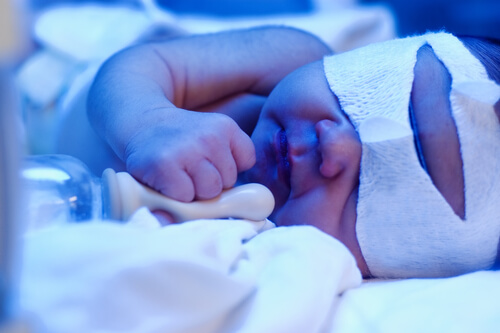Jaundice In Healthy Newborns


Reviewed and approved by the doctor Nelton Ramos
My baby, in his first days of life, has yellow skin. Is that normal? Yes, and it is likely jaundice. Do not be alarmed, jaundice is a temporary and harmless condition very common in newborns that disappears in the second week on its own, or with a slight treatment.
About 50 or 60 percent of babies have jaundice during the first or second week of life. Although most newborns have such a condition, it is not always perceptible.
Although it is rarely cause for concern due to its lack of severity, it is important to pay attention to it. In this article, you will discover how to know if your baby has jaundice, how to treat it and what consequences jaundice can bring to your child.
What is jaundice?
Jaundice is a frequent disorder in newborns, related to the yellowing of the skin and the sclera. This is caused by an excess of bilirubin in the blood, which results from the normal breakdown of red blood cells.
Normally, bilirubin is processed in the liver, eliminated in the form of bile, and excreted through the intestines in the stool. However, when it occurs rapidly and a newborn’s liver cannot break it down and eliminate it, jaundice appears.
In conclusion, jaundice is the result of a lack of maturation and adaptation of the liver after the series of changes that take place during the first few days of the baby‘s life. The bilirubin then deposits in several organs, mainly the skin, giving it a yellow tinge.

How to know if your baby has jaundice?
Jaundice can be detected by the parents, but requires that they are alert to any change in the coloring of the skin, the white part of the baby’s eyes (sclerotic) and the oral mucosa of newborns.
The most reliable method of detection is for parents to carefully observe the newborn under natural light or in a room lit with fluorescent lamps.
If there are still doubts, you can gently press the tip of their nose, forehead or chest. If the skin looks its usual color, they do not have jaundice. If you notice a yellowish tint, contact your doctor.
Can jaundice hurt my child?
The reality is that yes, jaundice can cause damage to the newborn, but only when the bilirubin reaches very high levels in the blood, thus becoming dangerous to the child’s health.
It is worth mentioning that the level of bilirubin represents a risk for the child depending on his or her age, weight, and other associated medical conditions. Check for the risk, a simple laboratory test is performed that requires only a small blood sample.
However, to investigate and clarify the reasons why the child has an increase in bilirubin, there are additional exams that must be conducted in a timely manner by the pediatrician.
Can I breastfeed a baby with jaundice?
There is no problem to breastfeed a child with jaundice, although sometimes it is a concern that this could be a possible prolongation of such condition. If so, the pediatrician may recommend temporary suspension of breast milk.
In these cases, maternity specialists point out that it is convenient to use suction pumps to stimulate the production of milk, in order to subsequently restart breastfeeding afterward.
However, it is always recommended that you immediately consult your doctor to guide you and take the necessary measures to diagnose and treat jaundice in a timely manner.

How is jaundice treated?
If the bilirubin levels are just slightly elevated, no special treatment is required and even daily sun exposure for 15 or 20 minutes through the window is sufficient.
This method is appealing because the newborn’s skin is extremely delicate, so much so that solar radiation easily degrades the bilirubin molecules and helps with their rapid elimination.
On the other hand, if these levels are a little more alarming, we resort to a treatment called phototherapy, requested and monitored by the pediatrician. To do this, special lamps are used that require the child to stay in the hospital for a few days.
The child’s blood is rarely replaced to eliminate bilirubin since this procedure is restricted only to special conditions. This intervention must be done in a hospital and under the orders of a pediatrician.
All cited sources were thoroughly reviewed by our team to ensure their quality, reliability, currency, and validity. The bibliography of this article was considered reliable and of academic or scientific accuracy.
- Doménech, E., González, N., & Rodríguez-Alarcón, J. (2008). Cuidados generales del recién nacido sano. Madrid: Asociación Española de Pediatría. https://www.seneo.es/Portals/0/Articulos/2.pdf
- Failache, O. (2002). Ictericia neonatal. Archivos de Pediatría del Uruguay, 73(3), 143-145. http://www.scielo.edu.uy/pdf/adp/v73n3/v73n3a07.pdf
- Martínez, J. C. (2002). Ictericia neonatal: existe un nivel seguro de bilirrubina. Arch Argent Pediatr, 100(4), 321-325. https://www.sap.org.ar/docs/publicaciones/archivosarg/2002/321.pdf
- Moraes, M., & Bustos, R. (2004). Ictericia grave en el recién nacido sano. Archivos de Pediatría del Uruguay, 75(2), 139-141. http://www.scielo.edu.uy/scielo.php?pid=S1688-12492004000200006&script=sci_arttext&tlng=en
This text is provided for informational purposes only and does not replace consultation with a professional. If in doubt, consult your specialist.








